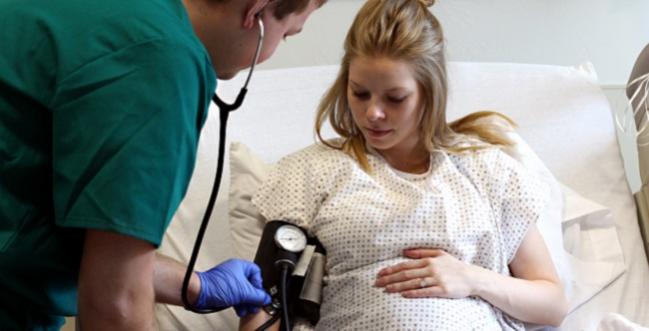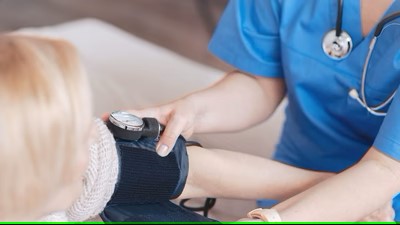MDF INSTRUMENTS
The Ultimate Guide to MDF® Medical Diagnostic Tools
Doctors, physicians, nurses, and all other health professionals heavily rely on diagnostic equipment to excel in their mission of caring for patients. These tools and devices are invaluable in all aspects of the healthcare process, from gathering vital health information in the patient assessment stage to guiding diagnostic decisions. Med practitioners can use them to pinpoint ailments and deliver precise treatments, making diagnostic devices the unsung heroes of healthcare.
There's no hospital, emergency room, outpatient care center, intensive care unit, home health agency, or long-term care facility that doesn't house a wide array of diagnostic medical equipment. That's just how ubiquitous and vitally important diagnostic instruments are.
In this blog post, we're taking a closer look at the most common medical devices that aid professionals in unraveling the mysteries of the human body. From the indispensable stethoscope to the classic sphygmomanometer and other essential diagnostic instruments that have revolutionized the medical landscape, we'll explore the various types and their significance in healthcare practice.
So, let's get started with the top diagnostic instruments you should know about.
Stethoscopes: The Crown Jewel of Diagnostic Equipment
Stethoscopes, the timeless symbols of healthcare, stand out as possibly the most vital type of diagnostic instrument.
Stethoscopes have a rich history dating back to the early 19th century when René Laennec invented the first version of the device by rolling up a paper tube and using it as a funnel. He realized that significantly amplified the sounds in his patient's chest. The invention came to bear the name 'stethoscope,' drawing from the Greek words stethos - 'chest' and skopein - 'to view or see.' From that point forward, stethoscopes kept advancing and improving to the powerful instruments that make a world of difference in healthcare today.
A range of medical conditions and inflictions can be identified by listening to internal sounds of the body.
Listening to heart sounds can help diagnose conditions like heart murmurs, arrhythmias, and valve irregularities. Also, lung sounds can reveal insights into pneumonia, bronchitis, and pulmonary congestion. Through blood pressure measurements, the distinctive Korotkoff sounds provide essential data for assessing both high and low blood pressure. Beyond cardiovascular health, stethoscopes are vital for detecting bowel issues, evaluating vascular sounds, and gauging heart valve function.
Suffice it to say these versatile diagnostic instruments work wonders in auscultating body sounds, helping professionals draw accurate healthcare assessments.
MDF Stethoscopes: Elevating Diagnostic Precision
Stethoscopes are the heart and soul of MDF's product line and have redefined how medical professionals auscultate.
Whether it's registered nurses, EMTs and paramedics, pediatric doctors, veterinarians, or other dedicated healthcare experts, MDF Stethoscopes have captured the trust and admiration of those at the forefront of patient care.
For the ultimate in cardiology-level precision, the ProCardial Titanium, Stainless Steel, and ProCardial Era collections are your go-to choices. Seeking versatility? The MD ONE series, available in titanium and stainless steel, covers all general clinical needs with unmatched precision. The Acoustica line is the perfect balance of affordability and functionality, making it the ideal choice for those looking for budget-friendly options without compromising quality.
Regardless of your chosen instrument, MDF's stethoscopes boast superior acoustic clarity, ergonomic design, and durable construction. With features such as non-chill rims, high-quality tubing, or the patented ComfortSeal eartips, each and every MDF stethoscope exemplifies the company's attention to detail and commitment to the comfort of both practitioners and patients.
Experience the game-changing potential of MDF Stethoscopes in your medical journey.
Sphygmomanometers: The Best Diagnostic Devices for Blood Pressure Readings
Blood pressure is a vital indicator of cardiovascular health, and sphygmomanometers are the go-to diagnostic device for measuring it. These instruments play a pivotal role in assessing systolic and diastolic pressures, which is crucial for diagnosing conditions such as hypertension. Their precision and reliability make them indispensable companions in clinics, hospitals, private practices, and even home healthcare setups.
Regular monitoring with sphygmomanometers is a cornerstone of proactive healthcare, paving the way for timely interventions, lifestyle adjustments, and informed treatment decisions.
MDF Sphygmomanometers: A Legacy of Craftsmanship
MDF stands as a true pioneer among sphygmomanometer creators. For over half a century, we've been crafting and improving these med diagnostic tools to achieve the world-renowned instruments we provide today.
The movement inside each MDF sphygmomanometer gauge is meticulously assembled by expert craftsmen who combine patience, dexterity, and an unwavering commitment to quality. Every device undergoes a stress test that subjects it to an astonishing 3,000 cycles and is calibrated five times, ensuring durability and reliability even under the most demanding circumstances.
The incredible attention to detail ensures that each blood pressure monitor operates flawlessly. So, healthcare providers who rely on accuracy can be confident they will have a device that's nothing short of the best.
Elevate your practice with efficient MDF sphygmomanometers.
Reflex Hammers: Top Diagnostic Instruments for Neurological Assessments
Reflex hammers serve as specialized medical diagnostic tools used in neurological assessments to evaluate the integrity and responsiveness of the nervous system's reflexes. Whether it's the familiar Taylor hammer, Babinski hammer, Tromner, or Queen Square hammer, each type targets different reflexes and aids healthcare professionals in detecting neurological peculiarities or signs of concern.
To use a reflex hammer, the doctor or nurse applies controlled and precise taps to specific body areas where reflexes are elicited. For example, a Taylor hammer commonly tests the classic knee-jerk reflex. Similarly, the Babinski reflex can be evaluated using a Babinski hammer. It involves gently stroking the sole of the foot, causing the toes to fan out. In a normal response, this reaction is only seen in infants, but if the response persists in adults, it might indicate an issue with the central nervous system.
Each type of reflex hammer is designed to target specific reflexes, and healthcare professionals must be well-versed in their usage to interpret the responses accurately. The information gathered from these reflex tests contributes to a patient's neurological health assessment and helps guide decisions regarding further testing, treatments, or interventions.
Check out the extensive MDF collection of reflex hammers. We've been crafting them since 1971, so we have the experience and the attention to quality required to provide some of the best neurological diagnostic instruments on the market.
Otoscopes: Essential Addition to Your Medical Diagnosis Kit for Auditory Health
When it comes to examining the ears, otoscopes are the solution for detailed insights.
Otoscopes allow healthcare professionals to uncover the secrets of auditory health. These diagnostic devices function as illuminated lenses, enabling healthcare professionals to peer into the delicate labyrinth of the ear canal and the eardrum. Otoscopes facilitate the detection of ear infections, the presence of foreign objects, and an array of other ear-related afflictions that might otherwise remain concealed.
Need an otoscope to elevate your medical practice? We've got you covered. Check out the Riester Otoscopes on our website.
Ophthalmoscopes: Common Medical Devices for Inspecting the Interior of the Eye
Ophthalmoscopes are part of the medical diagnosis equipment used to cater to the health of the eyes.
They play a vital role in providing a clear view of the intricate structures within the eyeball. By directing light into the eye and using lenses for magnification, ophthalmoscopes enable healthcare practitioners to identify issues like retinal disorders and optic nerve irregularities. This early detection is crucial for initiating timely treatments and managing eye diseases effectively. Because they are critical to facilitating accurate evaluations and preserving visual health and well-being, ophthalmoscopes serve as essential diagnostic tools that should be part of a healthcare practitioner's toolkit.
Head over to the MDF Instruments page to discover ophthalmoscopes for your practice.
Thermometers: One of the Most Ubiquitous Diagnostic Instruments
Accurate measurement of body temperature is an important pillar in medical diagnostics. And here's where the small but mighty thermometers come in handy. No list of medical equipment used in hospitals, private practices, or home health would be complete with this little tool that packs a punch.
Beyond the simple act of measuring temperature, thermometers play a pivotal role in monitoring body heat for the detection of fever, a vital indicator of underlying health conditions. Fever serves as the body's response to infections, inflammations, and other systemic disruptions. By continuously tracking body temperature, healthcare professionals gain a dynamic insight into the body's state, providing an early warning system for potential health issues.
From traditional oral thermometers to advanced infrared and digital versions, these diagnostic instruments provide quick and reliable temperature readings. As a result, healthcare professionals can make prompt patient care decisions, which is a key strategy for improving patient outcomes.
As medical science continues to evolve, the role of thermometers remains unwavering, steadfastly contributing to the early detection, effective treatment, and improved outcomes for people battling various health conditions.
Discover the digital thermometers available in our collection.
Penlights: Diagnostic Products to Make Your Practice More Efficient
Penlights may be small and unassuming in their appearance, but they deserve their spot in this list of types of medical devices as much as all the other entries.
They are handheld, portable light sources frequently used in physical assessments, particularly in neurology, ENT (Ear, Nose, and Throat) exams, and general clinical settings.
In medical examinations, penlights are often employed to perform the pupillary light reflex test, assessing the integrity of the cranial nerves and the brain's visual pathways. In ENT exams, penlights help evaluate the condition of the throat and oral cavity. Beyond these specialties, penlights are versatile tools that can be utilized in various clinical scenarios, making them an indispensable part of a medical practitioner's toolkit.
Discover MDF's comprehensive collection of penlights.
Tuning Forks: Diagnostic Tools Medical Professionals Use in Audiology Settings
Tuning forks find their essential role in audiology and various diagnostic tests. These metal diagnostic instruments, used in medicine for centuries, produce specific sound frequencies when struck.
They are simple yet effective in evaluating hearing and conducting hearing examinations. The Weber test helps identify hearing asymmetry, while the Rinne test assesses air and bone conduction to detect hearing loss and differentiate between sensorineural and conductive hearing impairments.
As such, tuning forks are invaluable tools for diagnosing hearing loss and related conditions. They help physicians understand the nature and extent of hearing impairments, guiding appropriate treatment and management options.
Get your tuning fork today.
Dermatoscopes: Diagnostics Instruments for Examining Skin Lesions
In dermatology, dermatoscopes are specialized diagnostic tools that provide a magnified and detailed view of skin lesions and moles. They can become great allies in the early detection of skin cancers and various dermatological conditions.
Dermatoscopes essentially function as magnifying lenses. This closer inspection reveals intricate patterns, colors, and textures that often remain invisible to the unaided eye. With digital dermoscopy, healthcare providers can capture and store images, facilitating remote consultations and improved documentation.
Are You Equipped with All the Important Types of Medical Equipment?
By blending an excellent education and abundant passion with top-notch diagnostics instruments, you'll become an unstoppable force whether you choose to pursue a career as a nurse, doctor, or any other healthcare specialization.
While we know you have the first two items on that list covered, we're here to provide you with some of the finest medical diagnostic equipment, enhancing and elevating your professional journey. With these tools at your disposal, you'll be equipped to deliver exceptional care and make a lasting impact in the healthcare field.




